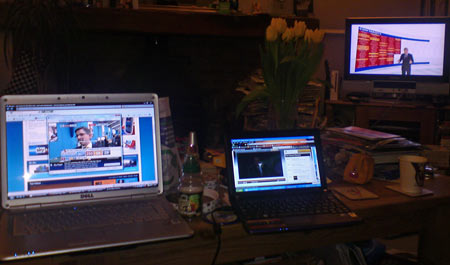It’s a paradox that characters in fiction tend, naturally, to be figments of the author’s imagination but also have to be real and credible enough for the reader to maintain the suspension of their disbelief. Of course authors piece together characters from traits they tend to observe in many different people in real life — Â but those different facets need to meld together to make a coherent whole.
I had a moment yesterday, while at Center Parcs Elveden, which was remarkably satisfying because I came across someone who not only looked similar to my character Kim but also seemed to have many of the exterior character attributes that I’d pieced together, which is great because Kim is probably the most complex and contradictory character in the novel.
Kim is able, for a while at least, to be something of a chameleon and be an efficient but sympathetic barmaid (or bar manager) whilst also having the disclipline and concentration needed to work on her artistic pursuits.  She’ll have a curious outward mixture of empathy and assertiveness whilst also combining an outwardly approachable, friendly  humour with a sort of inner-steeliness. (And she’ll also show anger and vulnerability to those who get to know her more closely.)
It was this unusual fusion of personality traits that I thought I recognised in the Center Parcs instructors working on what they called the Action Company Challenge Aerial Adventure. It’s like Go Ape ! which, ironically, James enjoys doing — maybe he sees something of the instructor in Kim? (I’ve done three Go Ape’s myself including the one in Aberfoyle in Scotland with the country’s longest zipwire at 426m that dangles you over 150 feet above a valley.)
In the Center Parcs Aerial Challenge participants follow a course ascending through a stand of conifers by negotiating about about nine obstacles placed between the trees (wooden beams, rope swings, rope ‘spiders’ webs’, wobbly bridges and so on). Â You eventually end up about 40 feet up on a tree and have a choice of getting down by 120m zip wire or just jumping off with a rope breaking your fall (you hope!).
In fact, the whole course is incredibly safe as, unlike Go Ape! there’s a safety wire permanently fastened and a high staff to customer ratio. Despite knowing it is safe, some people tend to get irrationally terrified even a few feet off the ground, partly as being elevated off the ground and swinging by a rope is such an alien environment.
So the qualities needed by the instructors are both assertive — I was shouted at to perch on a little wooden step to give my safety rope a yank to get it round a corner and also when I somehow tangled my safety line by going through a rope bridge the wrong way. On the other hand, Â some panic stricken people need a lot of encouragement to jump off a platform and swing across a gap of several feet hanging to a rope. It’s interesting as these people aren’t performing a straight pleasing-the-customer role, as might the waiting staff in one of their restuarants, as they also need to be able to try and generate a sense of cheerful confidence to get people around (although they sometimes have to lower people down on ropes who can’t face going further).
They also need to be very fit, professional — and probably a bit unusual. The woman working on the course managed to scramble up a 40 foot vertical pole to get ready to kit me out for the zipwire in the time it took me to get walk over a rope bridge. I was having a zip wire attached to me and had the strange experience that the person who was doing it was behaving exactly as I anticipated my main female character would act when at work meeting new people. Then I had to step off the edge and whizz down the wire.
Clearly, there are many dissimilarities — Kim is a German artist, which I doubt this climbing instructor was — she had a touch of Australian in her accent, although it may have been a very prononounced version of Estuary English. However, she also looked fairly like I imagine Kim to do, as much as you can tell under a safety helmet — she had quite a number of ear piercings.
Kim is meant to be quite distinctive looking — having fairly prominent facial features that she can either accentuate or soften — she’s an artist so she knows what effects she can achieve with her hair and make up should she be so inclined. James finds her at the start of the novel looking quite unattractive — and this disarms Emma to some extent — but she soon develops into someone whom Emma would like to see safely paired off (see comments under previous post).
I suppose if a character is synthesised using some imagination and lots of different sources, then there’s a decent enough chance of bumping into someone who can reflect that mixture of attributes at a certain time and circumstance — it verifies that those sort of personality attributes can plausibly combine together in a character — but it’s odd to discover this standing on a tiny platform up a tree 40ft high off the ground.
Now I only need to worry about how well I transfer the character out of my head on to the page and recreated in a reader’s mind.

